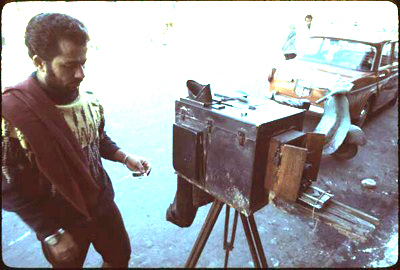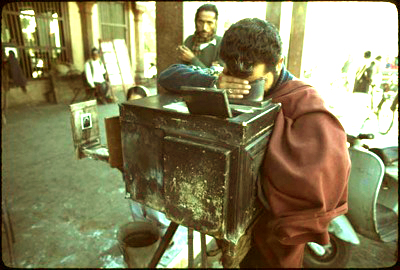Street Polaroid in a Box
I took these pictures of a portable street photo studio in New Delhi, India (I think) around 1975. I saw similar set ups in many parts of the Indian subcontinent (like Pakistan, Afghanistan, Nepal) in those years. They all operated the same way. It’s a low cost, low tech way of doing instant photograpy. Here’s how the system works.

The box is both camera and darkroom. The photographer aims the lens of the large box at you while you are standing in front of a cheesy painted background on a hanging cloth. The fllm he uses is a piece of plain photo paper about 3 inches square, rather than transparent negatives.The tolerances for moving paper around are less than small bits of film, so the camera can be made of cardboard or wood. He then develops the photo paper in the same camera/box using small dishes of photo chemicals stored inside the box. He does this by inserting his hands through cloth baffles. He looks at what is happening via a red-filter window in the top of the box. When the “negative” is developed, he takes it out of the camera/darkroom box. He then places this negative image in front of his lens (you can see one of these negatives at the end of the rail extending from the camera in the snapshot below). This image is enlarged slightly on a second larger piece of photo paper, and this time when it is developed inside the camera/darkroom, it turns into a positive image — a finished photographic portrait of you! So in fact, no film is used, only photo paper. The whole things happens in 5 or 10 minutes while you wait.

Photographers can also do touch-up work on the inter-negative image with a very fine brush – taking out blemishes or adding highlights to eyes, etc. The final results were quite acceptable, and of course very inexpensive. Very few people outside of tourists had or could afford a film camera then, so this was a very affordable way for most people to get their picture taken when they visited the city.
I have no idea if such camera/darkrooms are still used today.


